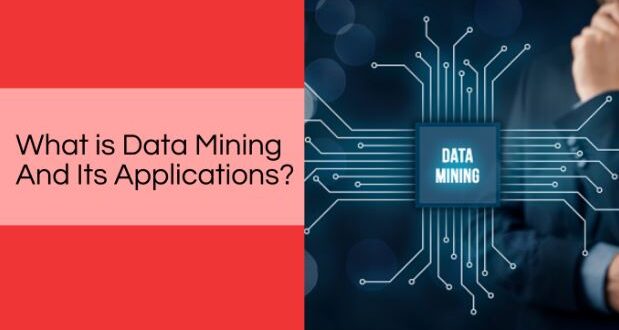What is Data Mining And Its Applications?

What is Data Mining And Its Applications?
Data mining is a technical process for mining a large amount of data to extract useful information. A large amount of data is stored in databases stored in the data warehouse. Extracting the required data from millions of data pieces is how mining works.
Data is extracted by finding patterns and correlations from a huge collection of data sources. Database systems, machine learning, and statistics are basic techniques used during data mining. Data is mined basically for discovering a large amount of data. The mining process has vague application areas and is mainly used for research, data science, and business functioning.
The useful data sets are extracted by identifying patterns between large-scale data for predicate analysis. After forecasting the data, certain data extraction complex algorithms are used to derive solutions based on the system model.
Some of the features of Data Mining are listed below.
- Data mining extracts useful information that is decision-oriented.
- It generalizes patterns of data sets that were not discovered before.
- The process makes sure that people are profited in the business resulting in effective marketing outcomes.
- It helps to maintain both operational and production patterns in an enterprise.
- The extracted data are usually reliable with no issue with redundancy and noise.
- Data is well selected, cleaned, formated, and transformed, defining data quality.
- Data sets are also generated following the mathematical model and statistical and machine learning models.
Data Mining Process in Detail
Data mining is done in multiple steps. Some of the data mining processes are:
-
Data Cleaning
Data cleaning is the process of removal of irrelevant and dirty data. Data inaccuracy is discarded by finding out the missing data and removing noise. Inconsistencies tuple, and central tendency are some of the steps carried out during data cleaning.
-
Data Integration
During data mining, multiple data sources are combined and studied. Heterogeneous data sets are integrated to remove inconsistency and redundancy to ensure data are reliable when given to end-users.
-
Data Reduction
Data reduction is when relevant data are analyzed from large blocks of data. Dimensionality reduction, numerosity reduction, and data compression are some of the steps carried out in this phase.
-
Data Transformation
Processes like smoothing, normalization, aggregation, and discretization are some of the strategies used during data transformation. Data transformation is done to better map data patterns and for code generation.
-
Data Mining
Clustering and classification are a few data mining applications used during data mining. The step makes sure the patterns in the data are properly represented and structured.
-
Pattern Evaluation
Visualization and data summarization are primary steps used during pattern evaluation. The process of pattern evaluation ensures that data are well-presentable and understandable by the end-users.
-
Knowledge Representation
Knowledge representation is the phase that represents how the data are presented to the users in the form of knowledge. Tables, reports, forms, etcetera are patterns based on which data are presented.
Application Areas of Data Mining
Data mining is used in many areas for the extraction of meaningful information from the bulk of data sources. It is used for the benefit of enterprises to enhance productivity and services. The procedure determines pricing, customer satisfaction, transactions, etcetera. I have enlisted some of the application areas of data mining; check the listings for more detailed information.
1. Financial Analysis
The fundamental application area of data mining is financial data analysis. It is the process of managing the finance and banking industry to extract reliable data blocks. Loan payments, details of the customer’s profile and loan, payment systems, credit ratings are some financial data mining techniques.
Financial data analysis includes the construction and management of data warehouses for analyzing meaningful data. It helps in clustering, smoothing, and classifying data based on customers’ credit policies and the loan payment system.
2. Manufacturing Engineering
The manufacturing rate and manufacturing process depends on the customer needs and requirements for specific products and services. Data mining is a useful technique for manufacturing engineering to evaluate patterns and structures in product development to sell best in the market.
Data mining in manufacturing engineering helps enterprises analyze a certain product’s architecture, consistency, and details. These products are then manufactured by studying the market’s needs. Product development proceeds to study costs and dependencies, resulting in a better manufacturing engineering outcome.
3. Healthcare
Another crucial application area of data mining is in the healthcare system. Data mining is best used for improving the healthcare system of the country. It defines the number of health problems likely to happen in the coming days and defines health solutions by discovered data.
Apart from enriching the healthcare system, data mining procedures ensure patients get proper health care facilities. The technology is also used to predict any uncertain diseases for health problems that are likely to attack humankind. Therefore, prevention beforehand of disease helps in discovering proper health care solutions.
4. Telecommunication Industry
With the advancement of technology, the telecommunication industry is expanding simultaneously. The telecommunication industry has been one of the major application areas of data mining. Fraudulent users, data traffic, system overloads, telecommunication patterns are tasks performed under data mining.
Data mining in the telecommunication industry helps keep track of mobile telecommuting patterns. Any unusual pattern is derived from telecommunication data to detect the efficiency of the service. Similarly, sequential multidimensional patterns are generated using data mining techniques and applications to enhance the telecommunication industries.
5. Education
Data mining is useful for education as data mining targets predictive learning. With the increased need and concern for education, data mining procedures can be useful to derive the type of education system to be established for better education in the future.
Based on the data, prediction on people’s choice for subjects is determined. The method is useful for establishing a proper educational guide and refining management to make institutions better choices for students. Besides, the specific students’ learning patterns and earning behavior can also be figured out using the data mining technique.
6. Business Analytics
An enterprise’s manufacturing, proper transactions, and decision-making ability are handled using data mining techniques. Data mining is used for business analytics because it helps to compare and contrast patterns in businesses’ data. Those data are used to extract useful information to make a further decision or solve business-related problems.
Moreover, data mining helps to track consumers’ consuming patterns. These patterns are useful to refine business strategies to increase business sales and introduce quality projects. Such behavior eventually balances the market and benefits both the service provider and the service consumer.
7. Market Basket Analysis
The consumer purchase behavior is analyzed using data mining, and the term used for the process is Market Basket Analysis. It is a technique that identifies the type of customer and their purchasing behavior that is referred to as the improvement of business protocol for enhancing sales.
The consumer’s purchasing behavior is studied to figure out their item needs. The data analysis is made on different customers and stores, usually through demographic groups. Predicting, cross-selling opportunities, pattern identification, etc., are some customer retention techniques applied using the data mining process.
8. Intrusion Detection
Data mining is used to secure the digital network and a system protected from intrusion. Data mining helps to extract meaningful information from larger packets of data that is useful for analyzing any intrusion in the system. It checks out the network traffic and discovers any unusual patterns of intruders.
The intrusion detection technique tracks any unauthorized behavior on the system, such as network attacks, virus attacks by hackers, and stealing confidential data sources. So, overall, data mining is used to check out daily activities on a network to discard any of the risks related to confidentiality, including integrity.
Conclusion
Data is an essential form of information and resources in every business sector with the growth in the use of technology. Processing meaningful information out of the stored data is data mining. Data mining is useful for carrying out day-to-day activities and enriching further education, healthcare, business transactions, etc.
I have listed 8 important application areas of data mining. Check out the information and let us know if it was helpful through comments.





